
All images © by Roberto Piperno, owner of the domain. Write to romapip@quipo.it.
Notes:
Page revised in July 2025.

All images © by Roberto Piperno, owner of the domain. Write to romapip@quipo.it.
Notes:
Page revised in July 2025.
 Rignano Flaminio and Faleria (Stabia)
Rignano Flaminio and Faleria (Stabia)If you came to this page directly, you might wish to read a page on Monte Soratte and S. Oreste first.
Some small towns in Italy had the same name; in the XIXth century when the country was
unified an adjective was added to their names to distinguish them, so Rignano became Rignano Flaminio,
after Via Flaminia, the ancient Roman road linking Rome with Rimini on the Adriatic Sea.
The Papal State was composed of four regions (Latium, Umbria, Marches and Romagna): Via Flaminia crossed them all so it
had a special relevance. Rignano was one of the last post stages before reaching Rome.
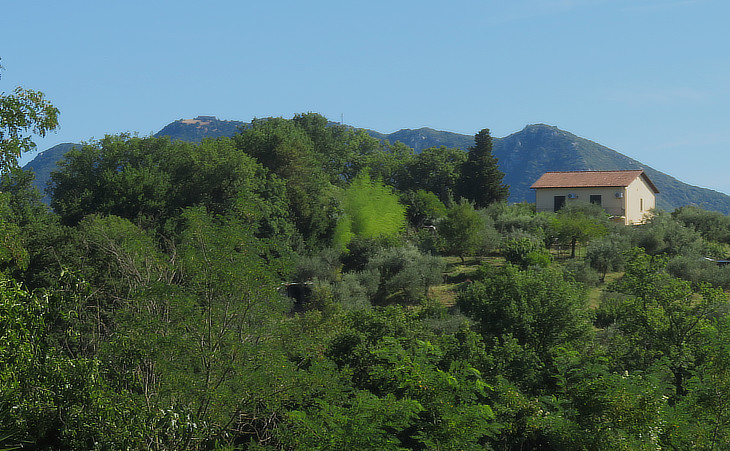
Monte Soratte and the countryside between Rignano and SS. Abbondio e Abbondanzio (see below)
We proceeded on to Arignano, a little town and a post-stage 8 miles. Heer we left the Via Flaminia and rode round a high hill (which stands single, and may be seen 20 miles forward to Civita Castellana).
John Ray's Observations (..) made in a journey through part of (..) Italy in 1663
March 1740. It was at Regnano, that in the middle of the night, after having had our horses harnessed and paid the post to the postilion who was going to take us, we were surprised to feel that we were not going. The reason for this, whether you like it or not, is that our cunning postilion, pretending to go and pee, had surreptitiously slipped through the alley with our money. The postmaster was never able to learn of this trick. He had to be given new sequins to be able to move forward. However, I always suspected him of having had a share in the glory of the invention.
Charles de Brosses - Lettres familières écrites d'Italie en 1739 et 1740 (learn about what occurred to another foreign traveller at the nearby post stage of Castelnuovo).
The Tiber flows
by the foot of this mountain (Monte Soratte), not far from which
lies Regnano de' Falisci, a small town situated on
a hill, and belonging to the house of Cesi. Near
this place you find again the antient Via Flaminia, whose pavement is near 2000 years old.
Thomas Nugent - The Grand Tour - 1756 edition
Having passed Rignano, the fourth post, the country begins to improve a little to S. Oreste,
and then to Civetta-Castellana. (..) Near Rignano our road lay over part of the Flaminian way; it is extremely firm and good, composed of very large blocks of stone, so nicely fitted and put together, and withal so smooth, that the horses could with difficulty keep their footing.
Anna Miller - Letters from Italy - 1771
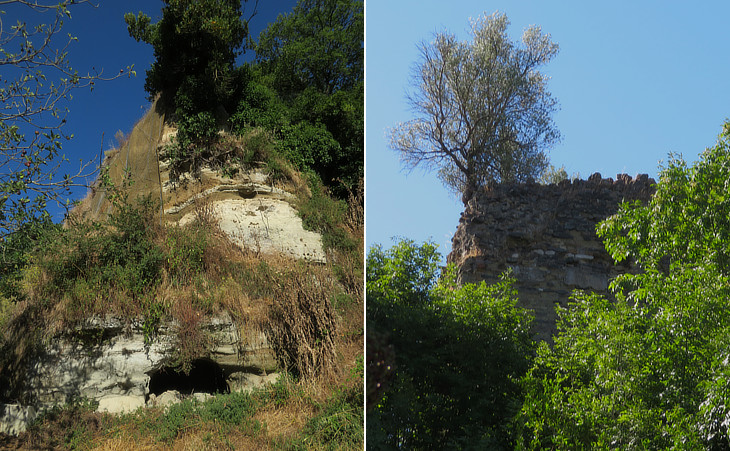
Countryside between Rignano and SS. Abbondio e Abbondanzio: (left) rocks; (right) a ruined defensive tower
On the approach to Rignano, the view is particularly fine; for beneath the town opens a wide ravine which seems to stretch up to the very base of Soracte, its cliffs overhung with wood, and a pretty convent nestling in its bosom. Around Rignano the land presents a singular stratification of white and grey rock - the white, called " cappellaccio" is a sort of friable tufo; the grey, with which it alternates, is a sandstone, in very thin layers.
George Dennis - The Cities and Cemeteries of Etruria - 1848
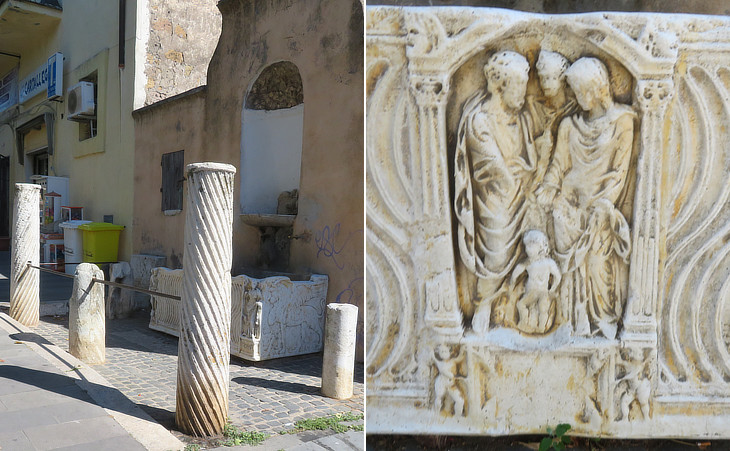
(left) Fountain; (right) detail of the sarcophagus depicting a Roman couple on their wedding day; it is very similar to a sarcophagus at S. Saba in Rome
Rignano.
A town, or large village, on the Via Flaminia, and
near to the ancient Mutatio. The ancient
Flaminian Way may not have passed through the precise site of Rignano, but along the valley below. The
place is scarcely four miles from St. Oreste; it contains
six hundred and thirty-four inhabitants.
Sir William Gell - The Topography of Rome and its vicinity - 1846 ed
It is evidently a Roman site, for altars, cippi, fragments of statues and cornices, and other traces of that people, abound in the streets. Dennis
Today Rignano
has a very modern, albeit anonymous, appearance and memories of
its past are scattered here and there in a rather out of context manner. The Borghese, to whom
the town belonged in 1607-1633, built a fountain which bore their heraldic symbols. In recent years it was embellished with an ancient Roman sarcophagus and some ancient Roman columns.
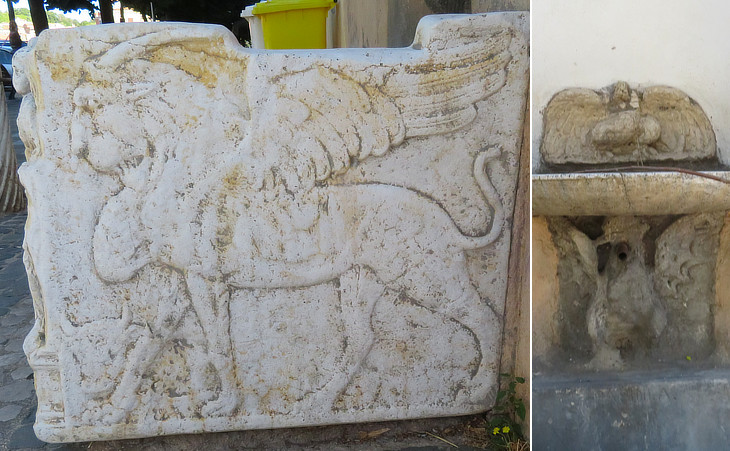
Fountain: (left) side of the sarcophagus depicting a mythological
beast; (right) eagle and dragon, heraldic symbols of
the Borghese
From Civita Castellana to Rome, the old and direct road follows the Flaminian Way, skirting the base of Mons Soracte, and proceeding through Capannacce, Rignano, Borghettaccio (Malborghetto), and Prima Porta; but it has fallen into disuse since Pius VI. constructed the high post-road through Nepi, in order to unite this with Via Cassia, the road from Florence, Siena, and Viterbo to Rome in 1787.
John Murray - Handbook for travellers in Central Italy - 1843
Rignano is a miserable town; tolerably flourishing, it is said, when the Via Flaminia, on which it stands, was the high road to Rome, but now falling into decay. (..) No one who values comfort will care to enter the osteria of Rignano. Woe betide the man who is compelled to pass a night within its walls. To avoid the companionship of squalid monks and disgusting cripples, I resolved to push on for Civita, though it was almost dark, and there were still nine miles before our jaded beasts. Dennis
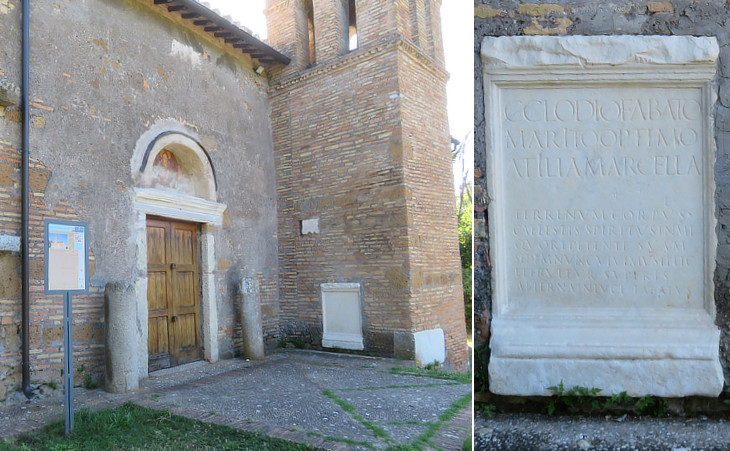
SS. Abbondio e Abbondanzio: (left) entrance; (right) ancient Roman inscription
Around the church of S. Abondio, which stands on a wooded height near Rignano, are many ancient remains, which, from the description given, appear to be all of Roman times. From the marble columns and capitals, the numerous fragments of architecture, and the sarcophagi and inscribed cippi which encumber the spot, it is concluded that a temple, of such magnificence as not to belie the description we have of the Fanum Feroniae, formerly stood here. Dennis
The church is actually in a depression at some distance from the medieval town in an isolated spot. Below the church can be seen the foundation
of an ancient temple, and fragments of wall in the neighborhood
are thought to belong to the boundaries of its area sacra. There
is no evidence as to the identity of the temple, because that dedicated to Feronia was eventually found near Fiano.
The ancient remains have been removed from the site because some of them were stolen. A very fine Roman inscription however is still walled near the entrance.
C(aius) Clodio Fabato/ Marito Optimo/Atilia Marcella/ Terrenum corpus caelestis spiritus in me / Quo repetente suam sedem nunc vivimus illic / Et fruitur superis aeterna in luce Fabatus. (To C. Clodius Fabatus, the best husband, by Atilia Marcella: My body is earth, but my spirit comes from the heaven, and desiring to return to its own place, we now live there and enjoy the eternal light of the gods, oh Fabatus). On a first reading this epitaph seems to be Christian, but it lacks the customary terminology of Christian
epitaphs. Moreover abundant parallels on undoubted pagan monuments for such an expression of confidence in the future life indicate that this is a pagan inscription.
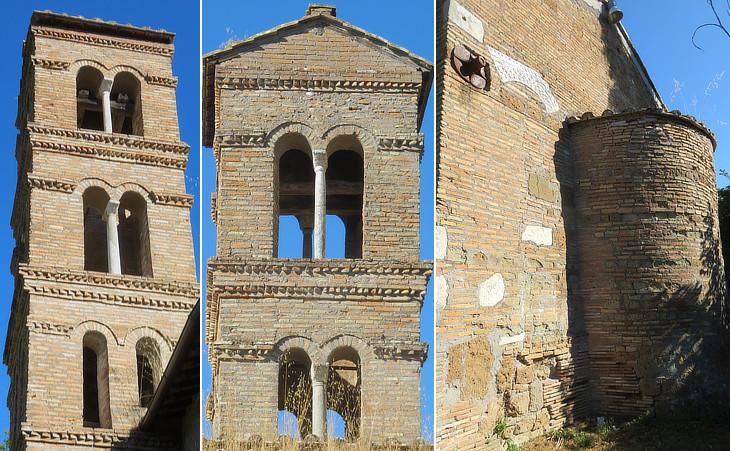
SS. Abbondio e Abbondanzio: (left/centre) bell tower; (right) apse
At a short distance to the north of Rignano is an extensive underground cemetery containing inscriptions many of which bear consular dates ranging from 344 to 424. Some of the undated inscriptions seem to go back to the beginning of the fourth century. This cemetery was the burial place of the saints Abundius and Abundantius. The only evidence for the lives of these saints whose names do not occur originally in the martyrologies is found in their passio, a document written before 1001 which records their martyrdom in the persecutions of Diocletian in 303. They were said to have been beheaded at the 10th milestone of the Flaminian Way and to have been interred by a certain matron Theodora in praedio suo milia ab urbe Roma XXVIII. To the edition of the passio published in 1504 is affixed an account of the discovery of the bodies of the saints and of Theodora in the church of S. Abundio in 1001, and of their transference by the Emperor Otho III to Rome. The church which was abandoned in the XVIth century because of its remoteness from the town is an interesting example of architecture between the VIIIth and the XIIIth century. The bell tower is the work of skilled masons, perhaps the same who built that of S. Maria del Carmine at Civita Castellana. Similar bell towers can be seen in Trastevere at S. Benedetto in Piscinula and S. Maria in Cappella.
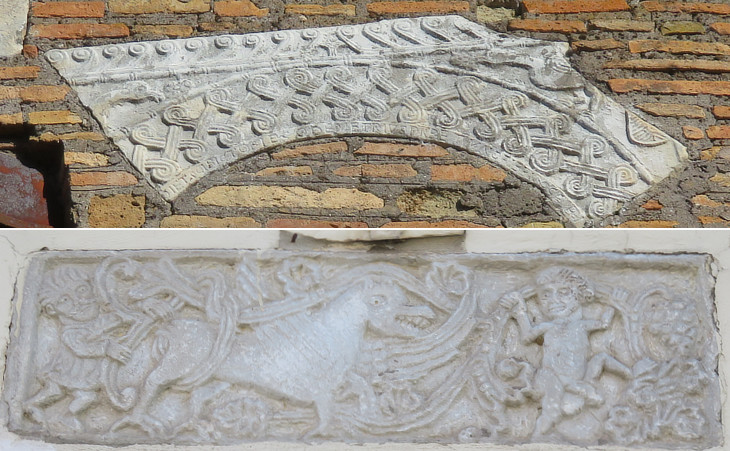
(above) SS. Abbondio e Abbondanzio: medieval relief on the wall of the apse; (below) medieval relief on the wall of a modern building in the town
An interesting fragment of the altar of the first church was placed on the wall of the apse. It follows a popular pattern of the early churches and it is very similar to a fragment at Castel Sant'Elia; the peacocks eating grapes are a symbol of Resurrection (see medieval reliefs depicting them at Viterbo, Cortona and a very fine relief of an ambo at Brescia).
The rudely sculptured relief depicting human beings and animals inside spirals of foliage, derives from Roman patterns (see some reliefs at S. Saba in Rome).
This type of reliefs was often used to decorate portals of medieval churches as at S. Maria Impensole at Narni and at the Cathedral of Rieti.
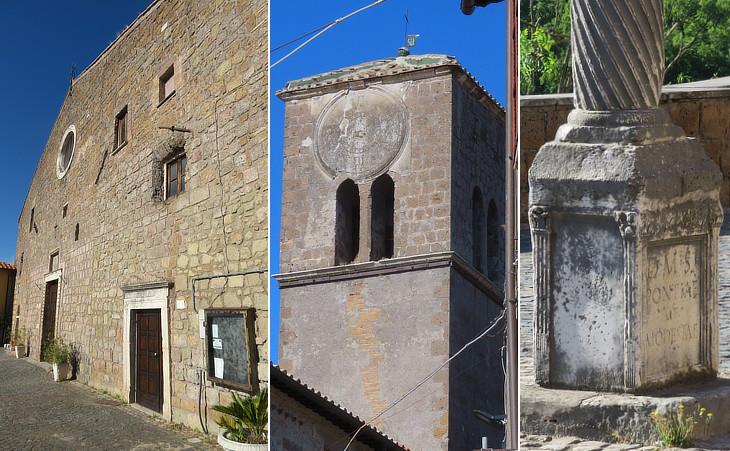
SS. Vincenzo e Anastasio: (left) façade; (centre) bell tower with evidence of a clock indicating the "Italian Hour"; (right) Roman funerary altar opposite the façade which supports the fine Roman column which appears in
the background of this page
The parish church is dedicated to two other martyrs. It incorporates an oratory and it was embellished with frescoes in the XVth and XVIth centuries. It is located at the eastern end of the medieval town from which a countryside lane leads to SS. Abbondio and Abbondanzio. Some of the ancient Roman remains near the latter church have been placed (or just stored) in a fenced area opposite the façade.
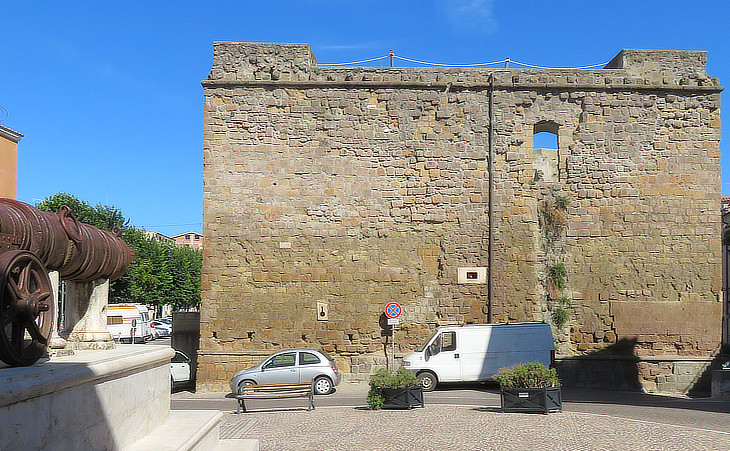
Rocca Savelli
The Savelli were one of the most important families of medieval Rome, especially in the XIIIth century, thanks to Popes Honorius III (Cencio Savelli) and Honorius IV (Jacopo Savelli). Rignano became a fiefdom of the Savelli at the end of the XIVth century. They had several fiefdoms in Sabina, e.g. Palombara. The small castle at the western end of the town was surrounded by a moat.
According to tradition when Cardinal Rodrigo Borgia was governor of Civita Castellana, Vannozza Cattanei, his mistress, resided at Rignano where some of the Cardinal's children were born. After his election as Pope Alexander VI, the town became a fiefdom of his son Cesare, before returning to the Savelli.
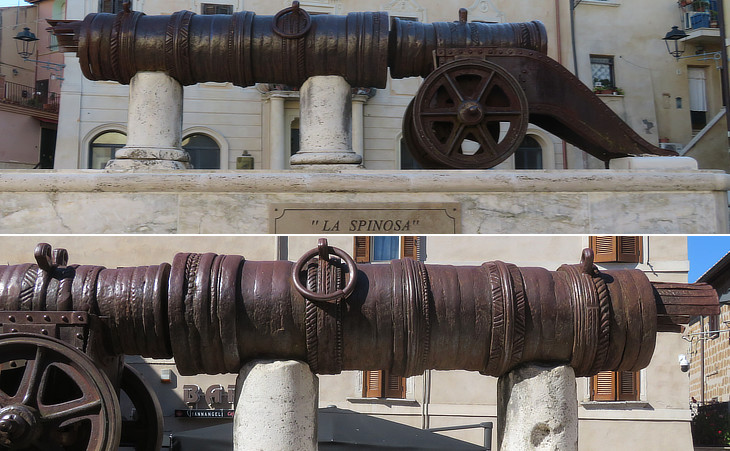
"La Spinosa" aka Borgia's cannon
There is also a curious relic of the middle ages, a primitive cannon, made like a barrel, with staves of iron hooped at intervals, and with rings attached to serve as handles. It is the counterpart of one I have seen, I think, in the armoury of Madrid. Rignano lays claim to be the birthplace of the infamous Caesar Borgia. Dennis
From S. Oreste one looks across a wooded country to the village of Rignano about 3 miles distant. It claims to be the birth-place of Caesar Borgia. Fragments of ancient columns and altars abound there, and in the piazza is preserved a curious primitive cannon. Rignano gives a title to the eldest son of Duke Massimo.
Augustus J. C. Hare - Days near Rome - 1873
A XVth century Spanish cannon in the main square
of the old town is traditionally associated with the Borgia, but it is now thought to have
been abandoned by the Spanish troops in 1527 when Emperor Charles V was at war with Pope Clement VII.
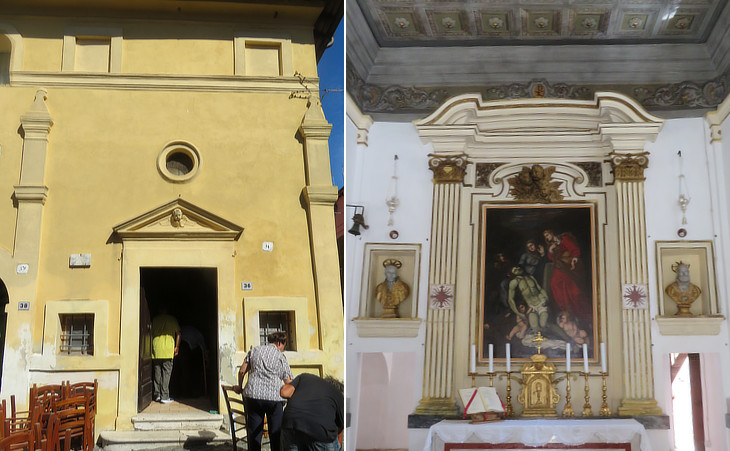
Chiesa di S. Maria della Pietà: (left) façade; (right) main altar with a copy of a painting by Annibale Carracci (see a similar painting at Castelnuovo di Porto)
This very small church was built in 1696 as a private chapel for the feudal lords of Rignano, as stated in a lengthy inscription inside the church. It is located in the relatively modern part of the town and it is now open to the public.
In the XIXth century Rignano was the location where travellers stopped to hire donkeys or horses to make their excursions to Monte Soratte.
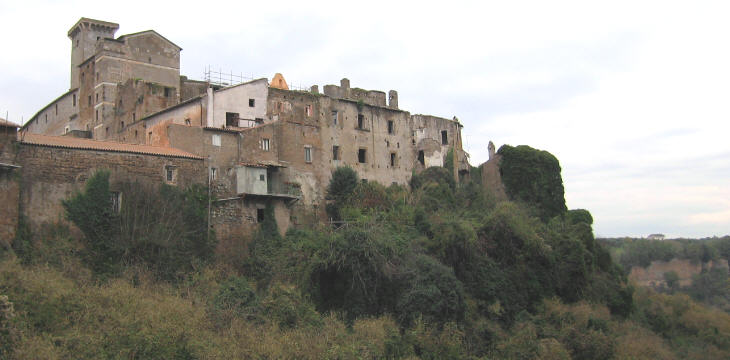
View of Faleria
There is a Stabia on the Flaminian Way - a deserted Osteria, not far from Mount Soracte. Gell
While Monte Soratte is made of limestone, the region to the west of the mountain is a low
plateau of tufa rock easily eroded by many small streams. In medieval times, for security
reasons, small sections of the
plateau situated between two ravines were chosen to found a new settlement. Caves were often cut into the tufa rock and the first inhabitants lived there, until in the
XIIIth century they started to build their homes above these caves. Stabia,
a small town now called Faleria, after
the Falisci, an ancient tribe living in the area, was built on the very edge of
two ravines, but those same ravines which assured its security caused over time the
collapse of most of the ground where the medieval town was located. This has happened
elsewhere and in a very dramatic way at Bagnoregio.
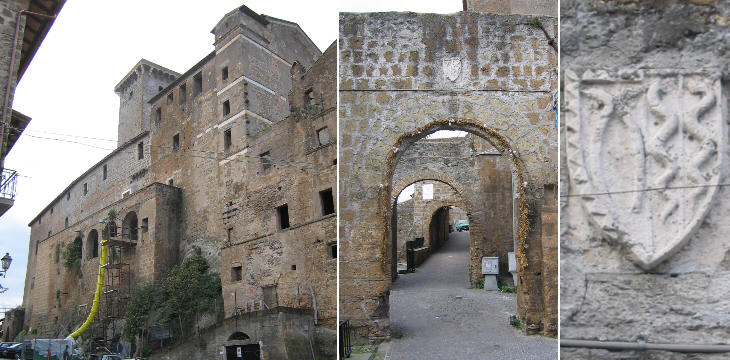
The Anguillara fortress and gate of the old town
The old town was protected by a relatively large fortress built by the Anguillara, a very powerful family whose coat of arms showed some eels, as anguilla in Italian means eel. In the XVIth century the medieval town was already almost entirely abandoned and the inhabitants moved into new houses protected by walls and towers: the fortress, which once protected the entrance to Stabia, became the final section of the new town.
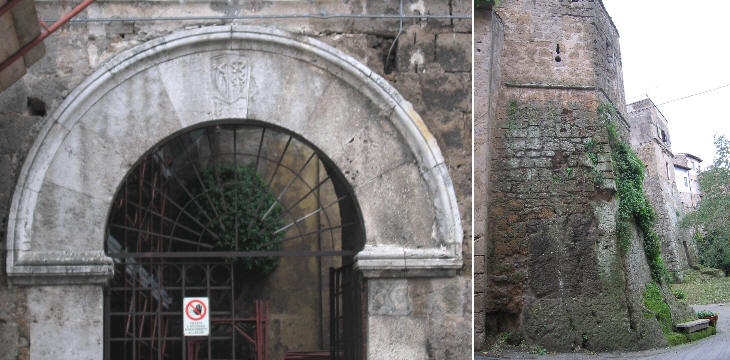
Detail of the fortress portal; towers which were
part of the town walls
In 1942 an earthquake seriously damaged Faleria and in the 1950s its inhabitants moved to new modern houses further away from the old town. In the late 1990s the municipality has implemented a plan to recover at least the square behind the fortress where an imposing parish church (S. Giuliano) built in 1298 is located.
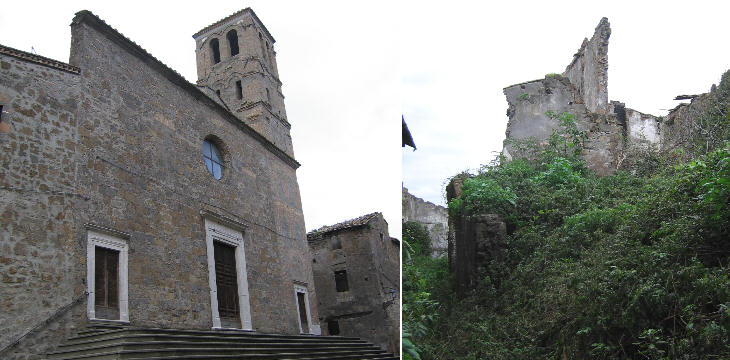
S. Giuliano and ruins of the old town
The year 1002 had already begun. Crushed by the news of the growing discontent of the German people, who threatened to crown another prince in place of the visionary enthusiast so long absent in Italy; disheartened by the delay of the auxiliaries, stricken with fever, the Emperor Otto the Third went in January to the fortress of Paterno, where Count Tammus, was in command, and where the Patricius Ziazo had joined him with troops from Pavia. To his fevered sight it seemed as if the whole of Italy were ablaze in one flame of rebellion; the monarch who had dreamed of restoring the universal Empire of the Romans found himself dying in an insignificant fortress, suffering from hunger and menaced by the insolence of his Roman vassals.
Ferdinand Gregorovius - History of the city of Rome in the Middle Ages - transl. by Annie Hamilton - 1897
The ruins of Castel Paterno are in a wood near Faleria.
Move back to Sant'Oreste.

